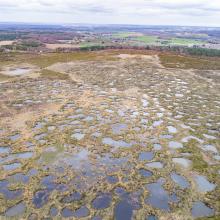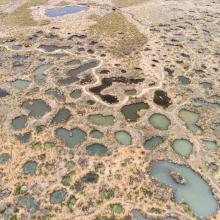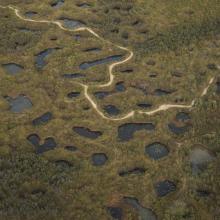


Le Pinail
- Country:France
- Site number:2461
- Area:923 ha
- Designation date:22-10-2021
- Coordinates:46°41'N 00°30'E
Materials presented on this website, particularly maps and territorial information, are as-is and as-available based on available data and do not imply the expression of any opinion whatsoever on the part of the Secretariat of the Ramsar Convention concerning the legal status of any country, territory, city or area, or of its authorities, or concerning the delimitation of its frontiers or boundaries.
Overview
Situated at the north-eastern end of the Moulière forest, Le Pinail is a unique complex of ponds and peat bogs, moors and wet meadows, deciduous and coniferous woodlands straddling a 923-hectare plateau between the Vienne and Clain rivers. The Site is one of the most representative and best-preserved examples of the “Poitou heathlands” with their characteristic shrub Erica scoparia, and features more than 7,500 ponds resulting from the extraction of silica rocks between the ninth and the nineteenth centuries to manufacture millstones. This mosaic of land and water environments provides rare habitats for dragonflies and amphibians. Overall nearly 2,500 species can be found, and many are nationally or internationally threatened such as the orchid Spiranthes aestivalis, the splendid waxcap mushroom (Hygrocybe splendidissima) and the globally endangered white-clawed crayfish (Austropotamobius pallipes), which normally only lives in streams but can here be found in ponds. Le Pinail is important for the purification and storage of water, regulation of local climate, and flood reduction. Some 10,000 visitors visit the Site each year; local communities benefit from the exploitation of forest plantations, hunting and the use of heather for fencing. The most significant threat is climate change: as the ponds are fed by precipitation, they are vulnerable to rainfall shortages and droughts, but also to the acidification of water and soils by atmospheric deposition and the increase of atmospheric CO2.
Administrative region:
Nouvelle-Aquitaine
- National legal designation:
- Réserve naturelle nationale - Réserve naturelle nationale du Pinail
- Regional (international) legal designations:
- EU Natura 2000
- Last publication date:22-10-2021
Downloads
Ramsar Information Sheet (RIS)
Additional reports and documents
- Site management plan
- Other published literature
